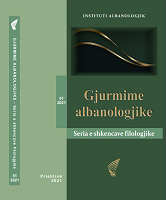RRËFIMTARËT E KUTELIT
KUTELI’S NARRATORS
Author(s): Gëzim AliuSubject(s): Albanian Literature, Interwar Period (1920 - 1939), WW II and following years (1940 - 1949)
Published by: Instituti Albanologjik i Prishtinës
Keywords: Kuteli; narrator; story; character; action; psychology;
Summary/Abstract: In this paper, starting from Gerard Genette's theory, but making a small modification, we have identified and analyzed the narrators in a series of narratives of several works by Mitrush Kuteli published before and during the World War II. In a large part of the stories, a narrator starts the narration, but does not tell about himself. The narrator tell a story that he has heard or was a witness of it or simply a spotter, but sometimes he also narrates about another character who is in his circle of his narrative, who begins to narrate about another circle, about another story. These are participatory narrators: some of them have an undistinguished identity, some have a partial identity, and some of them have a complete identity. There is e situation when the first narrator opens the story, but a little later, he transfers the narration over to another who narrates about his 'life'. However, in Kuteli’s stories we also find first-person narrators, who open the story, are involved in the narrated world, have a full identity, and are heroes of their stories. Nevertheless, sometimes happens that such characters stop telling stories about themselves and tell fairytales, but they also tell stories about others, to whom they relate in some way, by action or involvement of emotions. In some stories, we have the classic third-person narrator, but sometimes, especially in the beginning, it seems like they are participants in the narrated world. However, a little later, we see that is not the case, it is just the impression created by the use of 'folklore' nuances is the way of narration. The interweaving of narrators in Kuteli's stories never jeopardizes the motivational structure. In some stories, we find up to four narrators, but their narration within a story is a ‘natural’ part of the flow of stories. The activating of one narrator by deactivating another or vice versa becomes so ‘easily’ and enjoyable that the reader does not even notice it. I am talking about the reader who does not aim for narratological analysis. Meanwhile, for the analytical reader it gives a good material for analysis, as I believe we proved above.
Journal: Gjurmime Albanologjike - Seria e shkencave filologjike
- Issue Year: 2021
- Issue No: 51
- Page Range: 199-213
- Page Count: 15
- Language: Albanian
- Content File-PDF

